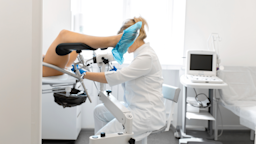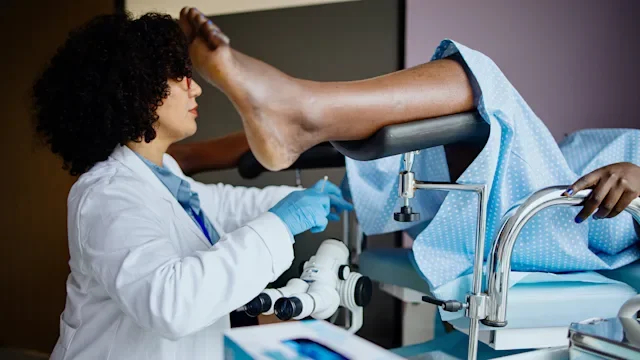Key takeaways:
An annual wellness exam (or “well-woman” exam) is your yearly health checkup.
At your wellness exam, your primary care provider will ask you questions about your health. They might also recommend screening tests, like a pelvic exam, Pap test, breast exam, or mammogram.
The right screening tests for you will depend on your age, medical history, risk factors, and personal preferences.
Your yearly wellness exam is also a good time to bring up any problems or questions you may have. Your primary care provider can be a great resource for learning about your mental, physical, and sexual health.
It might seem strange to think about going to the doctor’s office if you’re not feeling sick. But, even if you’re healthy, it’s a great idea to check in with your primary care provider from time to time for a wellness exam.
A wellness exam (sometimes called a “well-woman” exam) is a preventive care visit for women. Preventive care is medical care that helps to find problems — and treat them — before they become too serious. In other words, having a yearly wellness exam can help you stay healthy. That’s why physicians recommend that all women have an annual (yearly) wellness exam, starting in the teenage years.
A quick note before we get started. Though our language here mainly centers on cisgender women with typically female reproductive anatomy, at GoodRx we know that women (and their health needs) come in many different variations. All people are welcome here.
What happens during a well-woman exam?
A well-woman exam is a yearly visit to your doctor’s office to check on your overall health.
A lot of the time, a wellness visit focuses on your reproductive health. This often means checking on your vagina, uterus, or breasts. But in reality, this doesn’t have to be the only focus. A well-woman exam can be a chance for you and your primary care provider to talk about whatever is on your mind when it comes to your physical, mental, and sexual health.
A well-woman exam usually starts like any other doctor’s office visit. You’ll get checked in at the clinic, then meet with a healthcare professional privately in an exam room. Depending on what type of exam you’ll be having, they may ask you to undress and put on a surgical gown (it’s OK to say no to this if you don’t feel comfortable).
When you meet with your primary care provider, they’ll typically start with an interview — then move on to a physical exam, if needed.
Here are some topics they might cover during the interview:
Your personal medical history
Your family medical history
Whether or not you use tobacco, alcohol, or other substances
Your exercise and eating habits
Your pregnancy and childbirth history
Your menstruation history
Your mental health
Your past and current sexual activities
Read more like this
Explore these related articles, suggested for readers like you.
After talking with you for a while, they will do a physical exam. In some cases, this will include a pelvic exam or a breast exam. During the exam, they will let you know what’s happening at all times. It’s OK to ask questions, or to ask the healthcare team to stop if you feel uncomfortable at any time.
At the end of the visit, your primary care provider will likely have some recommendations for you. This may include changes to medications or your daily habits. They might also ask you to go for lab tests or other procedures. They’ll also let you know which — if any — vaccinations are right for you (such as COVID, shingles, and the flu).
The healthcare team should also leave some time for you to ask questions. But if they don’t ask — don’t be shy! Remember that your wellness visit is a great time to bring up anything on your mind.
Health screenings to expect during your well-woman visit
Health screenings are tests that doctors do to find out if there are any problems in your body, even if you don’t feel sick. The right ones for you depend on your age, your medical history, your risk factors, and your personal preferences.
Here are some screening tests that are often included in an annual wellness visit:
Hypertension screening (high blood pressure)
Screening for intimate partner violence
Screening for major depression
Testing for sexually transmitted infections (STIs)
Some of these screening tests can be done at your doctor’s office during the interview and physical exam. Other times, you may need to go to another lab or clinic to have the test done, like if you’re having a colonoscopy or mammogram.
Women’s health screenings by age
Well-woman health screenings change with age. Here’s a general overview of the health screenings that you should have throughout your lifetime.
Ages 13 to 20:
STI testing and/or pregnancy testing if sexually active
Check-in conversations about birth control options if needed
Ages 21 to 29:
Pregnancy and STI testing as needed
Pelvic exam and cervical cancer screening (Pap test) every 3 years
Yearly breast exam, starting at age 25
Check-in conversations about family planning and birth control as needed
Ages 30 to 50:
Pregnancy and STI testing as needed
Pelvic exam and cervical cancer screening (Pap or HPV test) every 3 to 5 years
Yearly breast exams
Mammograms from 40 years old (or earlier, if high risk)
Check-in conversations about family planning and birth control as needed
50s and beyond:
Pregnancy and STI testing as needed
Pelvic exam and cervical cancer screening (Pap or HPV test) every 3 to 5 years until age 65
Yearly breast exams
Mammograms every 2 years until age 74
Check-in conversations about birth control, as needed until menopause or age 50 to 55
Keep in mind that these are just general recommendations. Health screenings aren’t a one-size-fits-all model. Your primary care provider will personalize your health screenings based on your risk factors, your medical history, and your individual preferences.
How can you prepare for a well-woman exam?
It can be hard to know exactly how to prepare for a well-woman exam. Here are some tips that can help you have a successful visit:
Know your medications. Bring a list of all the medications you take, including over-the-counter meds and supplements. And bring information about the type of birth control you’re using, if any.
Know your menstrual cycle. If you menstruate, keep track of your period dates and bring them with you. Your healthcare team will ask about the first date of your last period and how long your cycle usually lasts.
Bring previous test results with you. If you’ve had screenings or tests in the past (like a Pap smear or mammogram), bring the dates and results with you. This is especially helpful if you’re seeing a new healthcare professional.
Bring a friend or family member for support. If you’re feeling nervous or uncomfortable about your visit, consider bringing another person with you for support.
Bring your questions. Remember that your wellness visit is a good time to bring up any questions or concerns you have. Your primary care provider is a great resource for learning about your body as well as your mental, physical, and sexual health.
Do you need to do anything special to prepare for your exam?
Not really. If you’re having a Pap smear, it’s a good idea to hold off on having sex a day or two before your appointment. But other than that, there’s nothing special you need to do to prepare.
You also don’t need to douche, or worry about “cleaning” your vaginal area too much. (Keep in mind that douching is never recommended under any circumstances, and it can actually cause health problems.) Overcleaning can irritate your genitals. In some cases, it can even make it hard for healthcare professionals to get accurate test results.
Can you get a pelvic exam or Pap smear if you have your period?
Yes. It’s absolutely fine to go to the doctor’s office if you have your period — even if you’re scheduled for a pelvic exam or Pap smear. Just be aware that if you’re actively bleeding, it’s possible that this could affect your test results.
Can you get birth control or STI testing without seeing a doctor?
Yes. If you need birth control or STI testing, you don’t need to wait for your annual wellness exam.
Certain states let you get your birth control prescription directly from a pharmacist, without having to see a doctor. And when it comes to STI testing, there are many different types of at-home STI kits available. It’s also possible to get birth control and STI testing through a telehealth (virtual) doctor’s visit.
The bottom line
An annual women’s wellness exam is an important part of staying healthy. This is true even if you’re feeling well and don’t have any specific health concerns. Wellness exams differ from person to person, depending on your age, risk factors, medical history, and personal preferences. Most of the time, they include a combination of an interview, physical exam, and additional screening tests.
All women should consider seeing a primary care provider for a well-woman visit on a regular basis. These visits are a great opportunity for you to check in on your health and address any problems or questions you may have.

Why trust our experts?



References
Centers for Disease Control and Prevention. (2021). Fast facts: Preventing intimate partner violence.
Centers for Disease Control and Prevention. (2023). When women can stop using contraceptives.
Planned Parenthood. (n.d.). What do transgender and cisgender mean?
Office on Women’s Health. Douching.
Taylor, A. (2020). Can you get a pelvic exam when you have your period? Planned Parenthood.
U.S. Preventive Services Task Force. (2018). Screening for cervical cancer: U.S. Preventive Services Task Force recommendation statement. Journal of the American Medical Association.


















